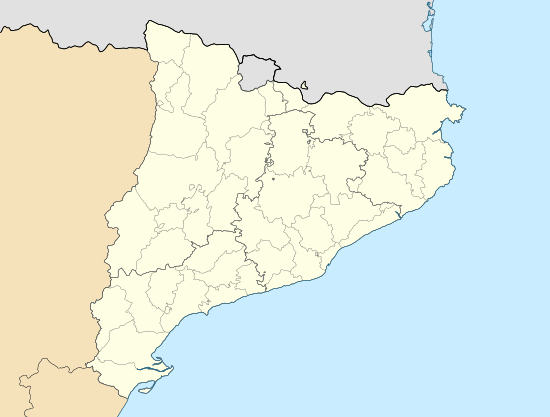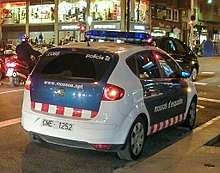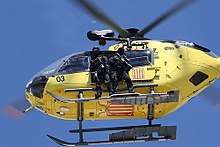Mossos d'Esquadra
| Police of the Generalitat of Catalonia – Mossos d'Esquadra Policia de la Generalitat de Catalunya – Mossos d'Esquadra | |
|---|---|
|
| |
| Common name | Mossos d'Esquadra |
| Abbreviation | Mossos |
| Agency overview | |
| Formed |
1721, as squads 1874–1939 / 1950–1983 as guards of the premises of the Delegation of Barcelona 1983 as autonomous police of Catalonia |
| Preceding agency |
|
| Jurisdictional structure | |
| Operations jurisdiction |
|
 | |
| Map of Police of the Generalitat of Catalonia – Mossos d'Esquadra's jurisdiction. | |
| Size | 32,114 km² |
| Population | 7,508,106 |
| Legal jurisdiction | Catalonia |
| Governing body | Generalitat de Catalunya |
| Constituting instrument |
|
| General nature | • Local civilian agency |
| Operational structure | |
| Overviewed by | Directorate-General of Police |
| Headquarters | Egara Central Complex, 08206 Sabadell |
|
| |
| Mossos | 16,869 |
| Minister (Conseller) responsible |
|
| Agency executives |
|
| Facilities | |
| Stations | 92 |
| Website | |
|
www | |

The Mossos d'Esquadra (Catalan pronunciation: [ˈmosuz ðəsˈkwaðɾə]; in English: Troopers, literally "Squad Lads", "Squaddies") are the police force of Catalonia, largely replacing the spanish Policía Nacional.
The force was founded in 1721 and named in the 19th century.
History
On July 21 1950 the Deputation of Barcelona was authorised to create a small security force using the historical title Mossos d'Esquadra. These new Mossos were a militarized corps having little similarity to the earlier incarnations, with limited powers and small numbers, which was in charge of protecting the government buildings of the Province of Barcelona. With the return of democracy to Spain, the Mossos d'Esquadra grew in number and powers. Since October 25 1980 the force has been under the authority of the Generalitat de Catalunya (the Government of Catalonia).
Previous Catalan forces
The Escuadras de Paisanos, later known as the Esquadres de Catalunya, (and informally known as the Mossos d'Esquadra), were men-at-arms who had fought as irregulars in the War of the Spanish Succession, and were brought together by the mayor of the town of Valls near Tarragona between 1719–1721. The corps was constituted as a militia to provide security to trade routes and fairs. It was created as a complement to the regular troops of the Bourbon army, which opposed the Miquelets, who survived as rebel supporters of Archduke Charles.
It was manned by local people, who had to speak Catalan and be familiar with the paths, caves and hiding places in the area. It was eventually placed under military jurisdiction but was less centralised than the Spanish police force (then known as the 'Intendencia General de Policía') formed in 1817, or the yet-to-be-established ‘Guardia Civil’, both of which were systematically deployed away from their home regions, and thus strangers to the places where they served. Throughout the centuries it has passed back and forth from Catalan authority to Spanish military command several times. They were dissolved in 1868 by General Prim after the fall of Queen Isabella II of Spain, since the Mossos had always been royalists.
They were reinstated in 1876 under the reign of Isabella's son king Alfonso XII of Spain, but only in the province of Barcelona. Under his son Alfonso XIII of Spain, the Mossos were not well regarded in Catalonia, especially by the Commonwealth of Catalonia, who paid them but had no control over them. They flourished, though, under Primo de Rivera's dictatorship. When the Second Spanish Republic was proclaimed, however, the Mossos sided with the Generalitat de Catalunya. After the Spanish Civil War, the last Mossos left Catalonia with the President of the Generalitat, and the corps was dissolved by the Francoist authorities.
Current role

The Mossos d'Esquadra have now replaced Spain's Guardia Civil within the territory of Catalonia. This process of substitution began in 1994 and was completed in 2008.[1] In November 2005, the Mossos took full duties in the city of Barcelona.
The Statute of Autonomy of Catalonia[2] (Catalan: Estatut d’Autonomia de Catalunya) defines that the scope of action of the Generalitat Police Force – Mossos d'Esquadra is the whole of the Catalan territory, and states that it exercises all the functions of a police force in the following fields:[3]
- Public safety and public order.
- Administrative policing, including that deriving from State regulations.
- Judicial policing and criminal investigation, including the various forms of organised crime and terrorism, in the terms established by law.
The Mossos d'Esquadra are a police force of the Spanish state placed under the authority of the Generalitat de Catalunya within the territory of the autonomous community of Catalonia. The Policia Nacional and the Guardia Civil, on the other hand, are commanded directly by the Spanish ministry of the interior. They keep some officers in Catalonia to support the fight against terrorism, to handle identity documents, immigration and other limited responsibilities of the central government.[4] However, when there was a dispute between the governments of Catalonia and of Spain about Catalonia becoming independent, and the Catalonian government called a referendum for 1 October 2017, the Spanish government sent thousand of members of the national Guardia Civil to Barcelona with the intention of preventing voting.[5] as the referendum was illegal according to the sentence of the Spanish Constitutional Court.
The Mossos are trained in the Institut de Seguretat Pública de Catalunya (Public Safety Institute of Catalonia), which also trains local police officers.
| Rank | Mosso | Caporal | Sergent | Sotsinspector | Inspector | Intendent | Comissari | Major |
| Insignia |  |  |  |
- Salary[6]
Armament and diverse material
This area has a large quantity and variety of weapons. Each of the weapons is assigned only to one GEI The long list includes:[7]


- HK rifles model PSG-1 - Cal. 7.62x51mm NATO (.308 Winchester).
- Rifles SAKO TRG-22 - Cal. 7.62x51mm NATO (.308 Winchester).
- M110 Sniper - Cal. 7.62x51mm NATO
- AMP DSR-1 Rifles - Cal .338 Lapua Magnum.
- MP5 subheaders - Cal. 9x19mm Parabellum.
- MP5 MP subheaders - Cal. 9mm (of plastic ammo).
- HK P90 subwindles - Cal. 5.7x28.
- HK G 36 KV subheadings - Cal. 5.56x45mm NATO (.223 Remington).
- HK G 36 subwindles - Cal. 5.56x45mm NATO (.223 Remington).
- FN SCAR
- HK MP7 sub-machines - Cal. 4.6x30.
- Shotgun Franchi - Cal. 12 gauge.
- Remington 870 shotguns - Cal. 12 gauge.
- Shotguns Faber SPA 8 - Cal. 12 gauge.
- Pistols P 30 L - Cal. 9x19mm Parabellum.
- Pistols HK USP - Cal. 9x19mm Parabellum.
- Pistols FN Five-seveN - Cal. 5.7x28.
Of course, other elements such as helmets, protection goggles, various types of vests (bullets, antitrauma ...), various defenses (the traditional "porra", the extensible ...), ariets to burst doors , bulleted shielded shields, "SWAT cam" (extensible cameras that let you check if someone is in a room before entering), and many others.
In the most common interventions each one is equipped with a sub-machine gun and two pistols.
Vehicles
- The vehicles are Patrol and discreet, high-powered cars and vans. They also have an armored 4x4 vehicle (NIJ IV level). They also use helicopters from the Generalitat de Catalunya.
Controversies and legal cases
Due to the political situation in Catalonia, the Mossos d'Esquadra have gained notorious popularity as an unreliable police more dependable on the pro independence autonomous government than to the Spanish Judicial System[8]. In addition:
- In 2008 three Mossos were condemned to six years of imprisonment for the torture and injury of an alleged delinquent who was later proven not guilty[9]. Later, in 2009 the Tribunal Supremo reduced the sentence[10]. And finally in 2012 they were paroled[11].
- In 2016 six agents were detained for their involvement in a cardiac failure of a businessman in the Raval neighbourhood[12].
- In 2017 the major was ceased during the application of the 155 Article of the Spanish Constitution. Also, an investigation was opened to determine the role of this police during the 1st of October Acts.
Gallery
 Mosso d'Esquadra in dress uniform
Mosso d'Esquadra in dress uniform A patrol car in Barcelona
A patrol car in Barcelona
See also
References
- ↑ "El desplegament de la Policia de la Generalitat – Mossos d'Esquadra" [The deployment of Police of the Generalitat – Catalan police] (PDF) (in Catalan). Catalonia, Spain: Generalitat de Catalunya. November 2006. Archived from the original (PDF) on 6 July 2011.
- ↑ "Statute of Autonomy of Catalonia". Wikipedia. 2017-09-21.
- ↑ Statue of Autonomy of Catalonia 2006, Article 164.5 on Public Security – http://web.gencat.cat/en/generalitat/estatut/estatut2006/titol_4/
- ↑ "Funcions de la Policia de la Generalitat – Mossos d'Esquadra" [Functions of the Police of the Generalitat – Catalan police] (PDF) (in Catalan). Catalonia, Spain: Generalitat de Catalunya. Archived from the original (PDF) on 27 February 2008. Retrieved 20 April 2012.
- ↑ "Catalonia referendum defies Spanish obstruction". BBC News. 30 September 2017. Retrieved 30 September 2017.
- ↑ http://governacio.gencat.cat/web/.content/funcio_publica/documents/empleats_publics/retribucions/2016/Mossos-2016.pdf
- ↑ ca:Àrea dels Grups Especials d'Intervenció#cite note-Montoto-3
- ↑ PAÍS, Ediciones EL. (in Spanish) "Noticias sobre Mossos d'Esquadra" Check
|url=value (help). EL PAÍS (in Spanish). Retrieved 2018-08-31. - ↑ País, Ediciones El (2008-11-26). "Seis años de cárcel para tres 'mossos' por torturas y lesiones a un detenido". El País (in Spanish). ISSN 1134-6582. Retrieved 2018-08-31.
- ↑ ABC. "El TS rebaja la pena a los «mossos» condenados por torturas a un detenido | Cataluña | Cataluña - Abc.es". ABC. Retrieved 2018-08-31.
- ↑ Razón, La. "El Gobierno indulta de nuevo a cuatro Mossos condenados por torturas". www.larazon.es (in Spanish). Retrieved 2018-08-31.
- ↑ "Los mossos del «caso Benítez» acuerdan a última hora una pena mínima para librarse de la cárcel". abc (in Spanish). Retrieved 2018-08-31.
External links
| Wikimedia Commons has media related to Mossos d'Esquadra. |